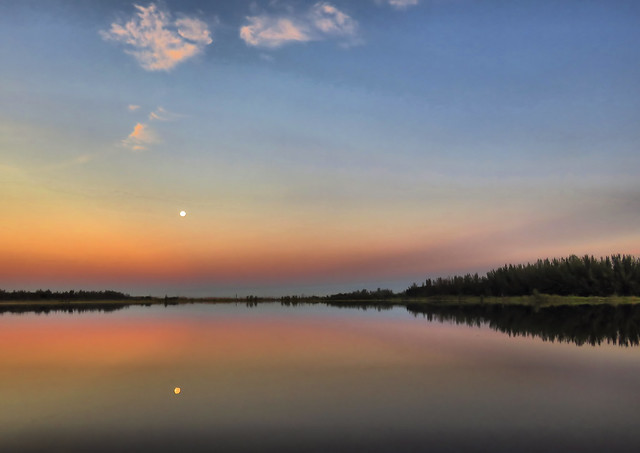
We start our walks facing due west, and follow a gradual 90 degree curve to true north. My first stop is at a small peninsula which juts out westward into the lake. Just after sunrise, it acts as a sort of sundial of the seasons. With the Autumnal Equinox approaching my shadow falls full on the path ahead.
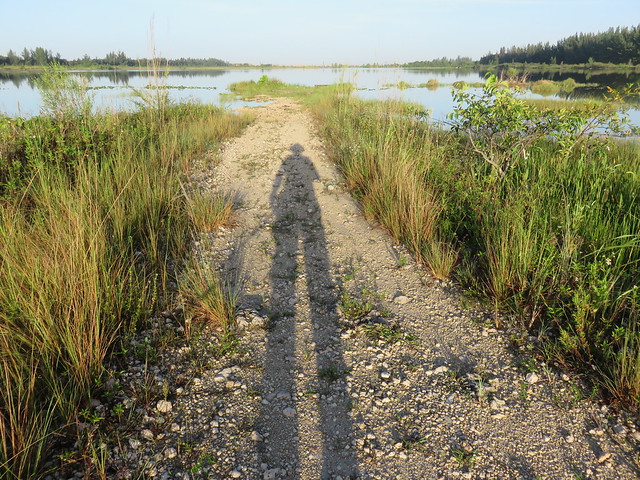
The sun will soon rise within the frame created by the back gate of the adjoining subdivision directly east of this location:
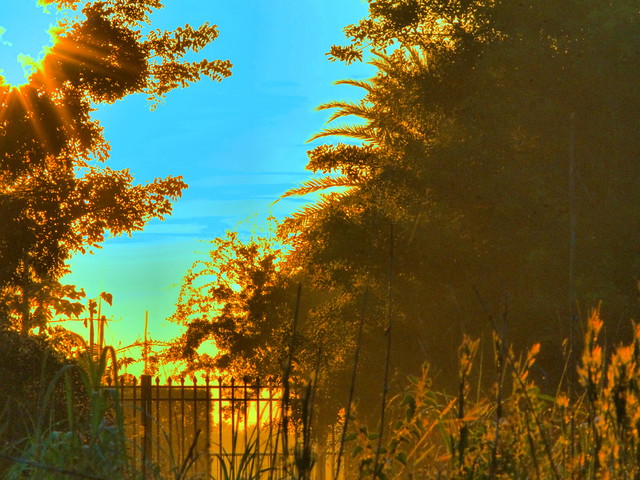
Migratory birds began appearing a few weeks ago, providing a departure from the uniformity of the summer bird population. Shorebirds are often the earliest arrivals. This year we saw few, as there are no extensive mud flats because of the high water levels. The little peninsula path has sometimes been under ankle-deep water.
Spotted Sandpiper showed up first, on September 12. Note its pronounced eyebrow line and how the white of its breast extends up in front of the shoulder:
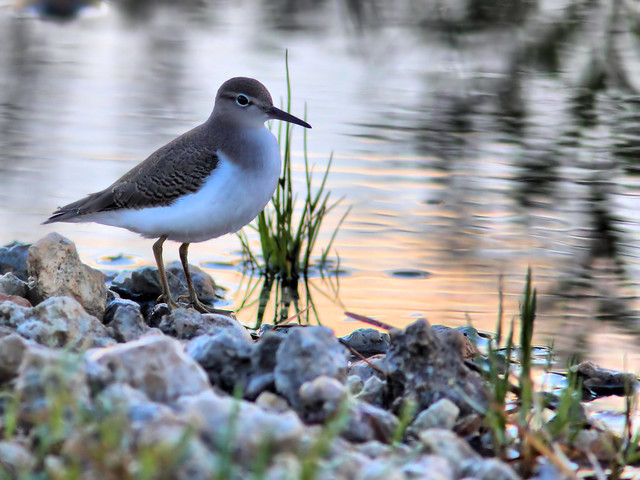
I heard the distinctive call of a Lesser Yellowlegs a few days earlier, but finally saw one flying over, on September 13:
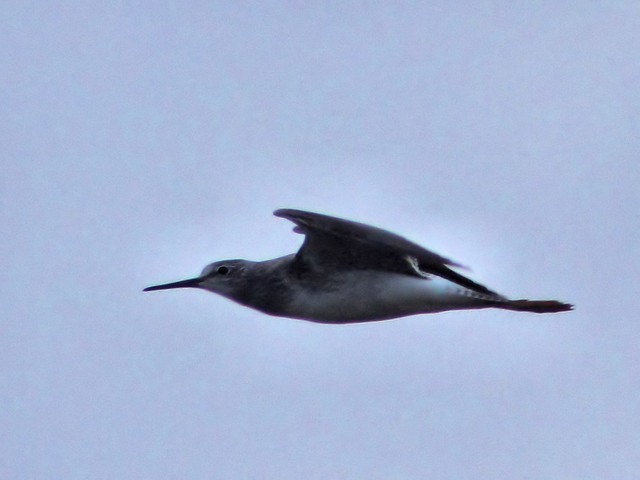
Here is a side-by-side comparison of Greater and Lesser Yellowlegs, taken back in 2014. In addition to its larger body size, the bill of the Greater Yellowlegs (in background) is longer and curves slightly upwards. Two Least Sandpipers may also be seen, to the left in this photo:
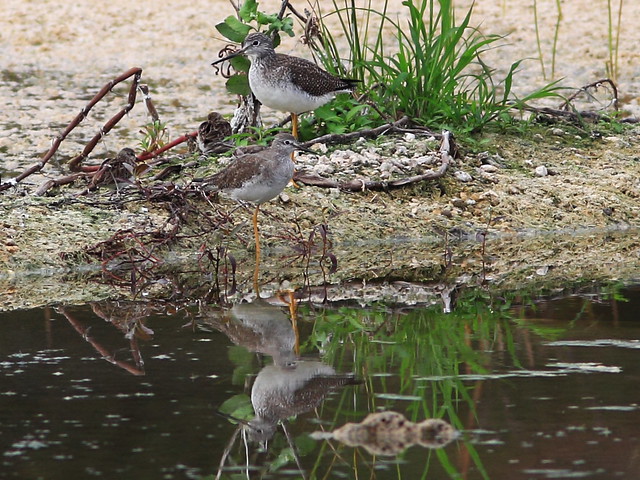
Least Sandpipers followed on September 15:
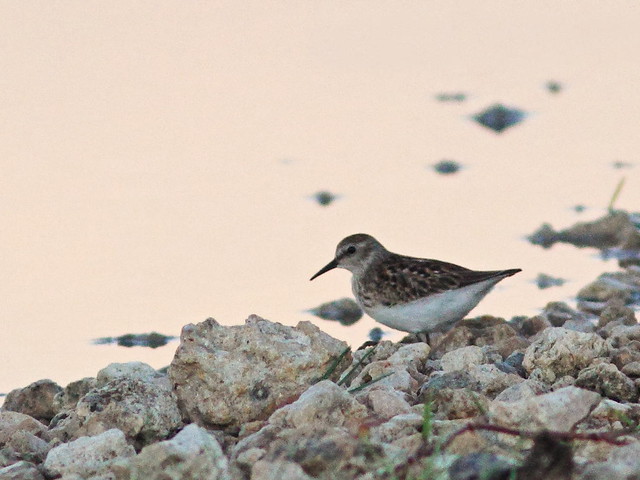
A Solitary Sandpiper appeared on September 17:

The Spotted and Solitary Sandpipers are rather similar in appearance during the winter, when the former species loses its breast spots. They are present in this unusual side-by-side comparison of the two species, back in the spring of 2015:
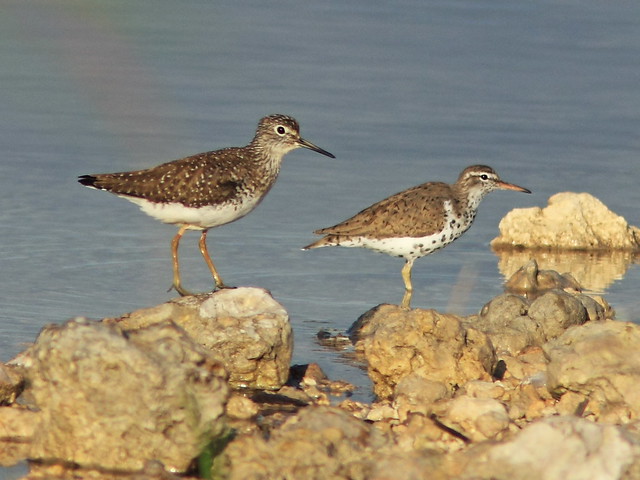
We have only two regular resident warbler species, the Common Yellowthroat and the Prairie Warbler. As fall approached, their populations were gradually augmented by arrivals from the north.
This is a female Common Yellowthroat in a Firebush (Hamelia patens) on September 17. The male has a striking black mask:
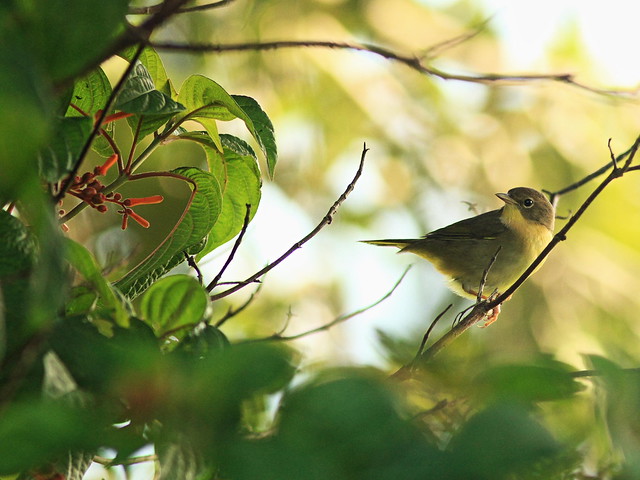
Prairie Warbler, also photographed on September 17:
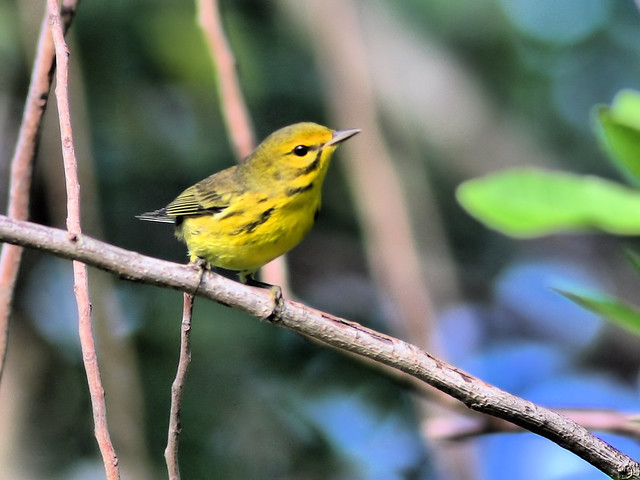
Other arriving warblers included the Black-and White Warbler (September 7)...
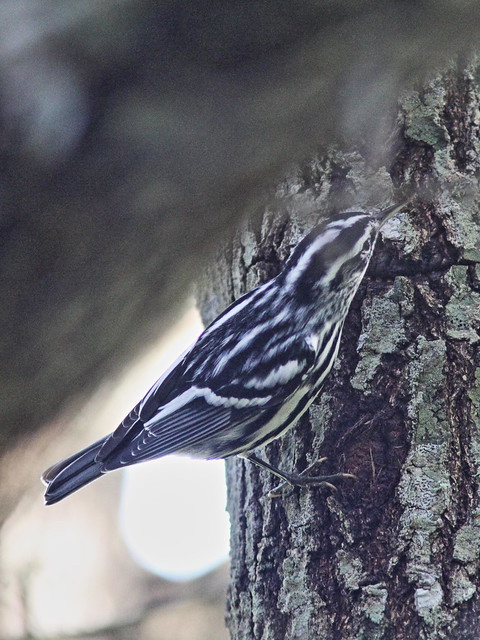
...Yellow-throated Warbler (August 20)...
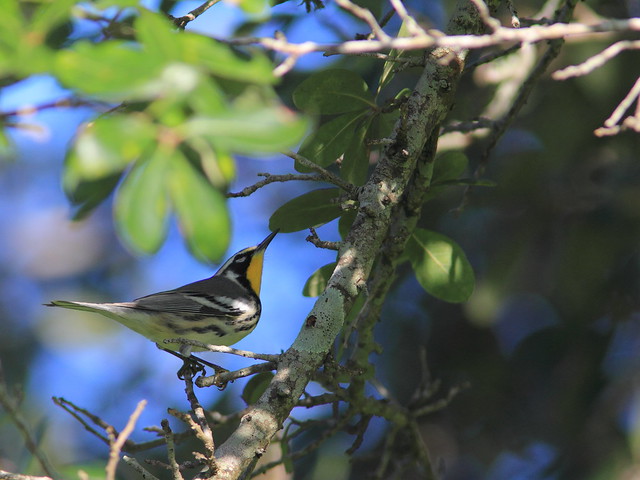
...an Ovenbird (September 17)...
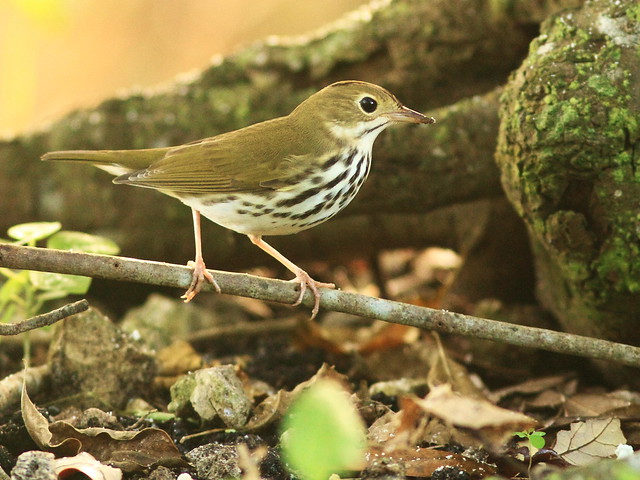
...Northern Parula (September 13)...
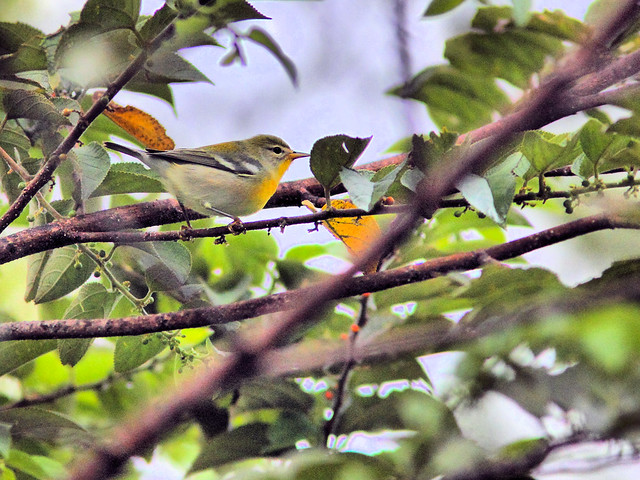
...and, among other warbler species, the American Redstart. This is an adult female, in which yellow replaces the fiery red in the adult male's plumage (September 16):
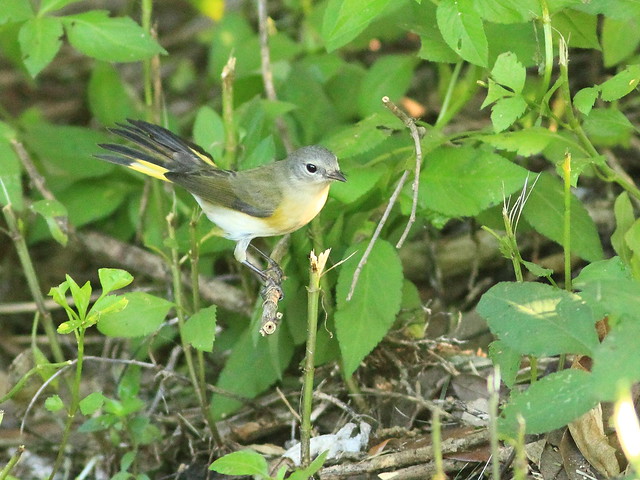
A Red-eyed Vireo provided a pleasant photo-op on September 17):
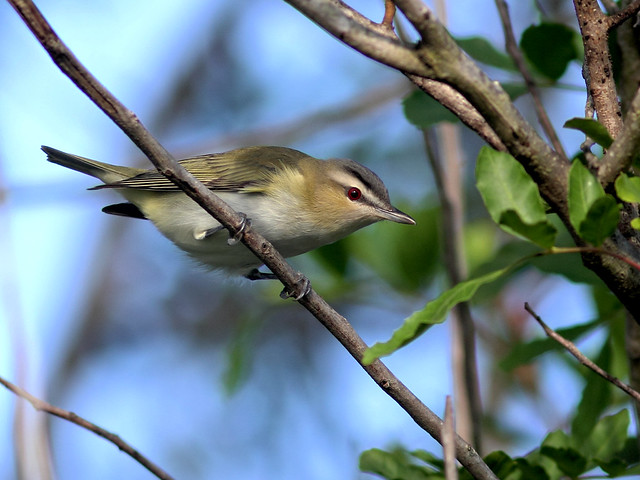
Some flycatcher species came in early, notably the Eastern Kingbird (September 5):
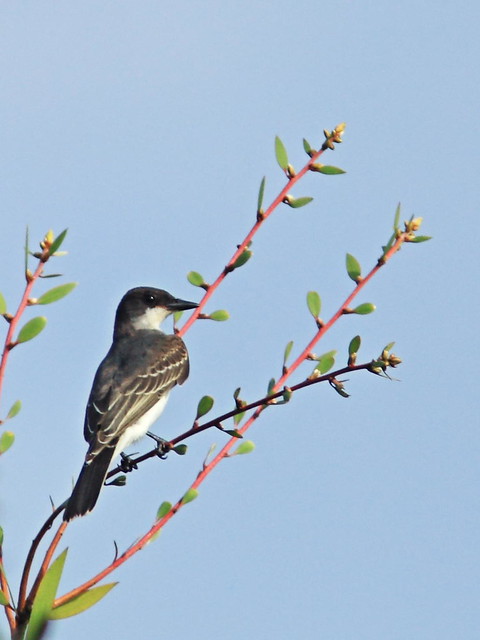
We are within the Great Crested Flycatcher's breeding range but do not see them until they wander after nesting (August 20):
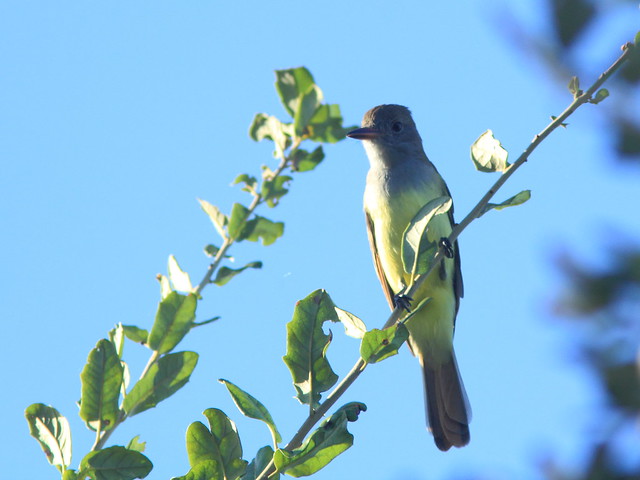
This is a diminutive member of the Alder/Willow Flycatcher complex in the Empidonax family. These two species can be distinguished from each other by their calls. Unfortunately, this specimen was silent (to my ears) but over a 7 day period readily responded to the recorded call of the Alder Flycatcher and ignored that of the Willow. Finally I obtained a recording of its voice, which clinched the identification as an Alder Flycatcher (September 9):
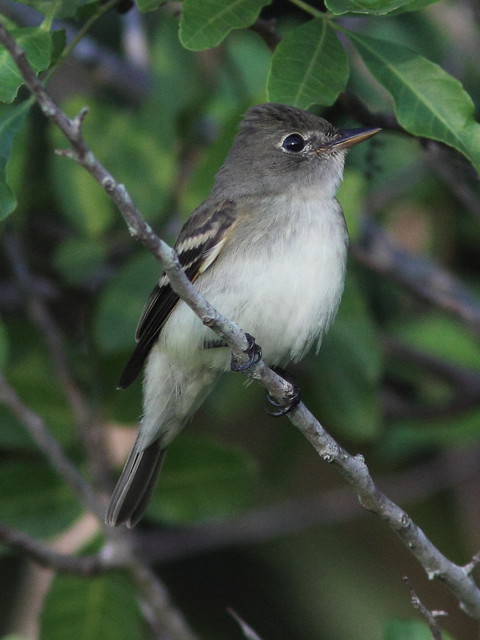
Blue-gray Gnatcatchers can become so numerous as to be a distraction, but their antics are fun to watch and they often are accompanied by other migrants (September 6):
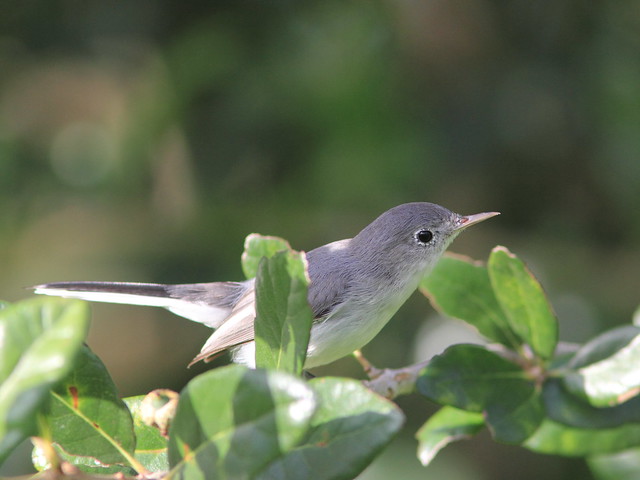
Other migratory treats so far have been a Merlin which I spotted as it roosted along the path in semi-darkness about 20 minutes before sunrise on September 18.
Because of the poor light (Camera settings were 300 mm lens at f/4.0, ISO 3200, exposure 1/40 sec, exposure compensation +2/3) my hand-held image of this small falcon is a bit soft :
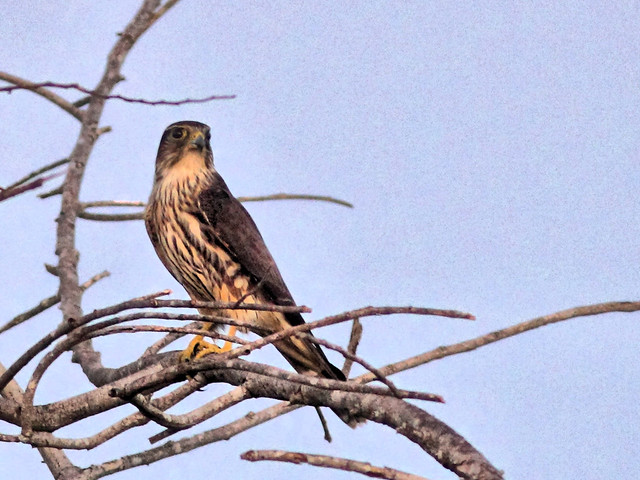
A Peregrine Falcon was an even more challenging subject, as it was nearly a quarter of a mile away (September 14):
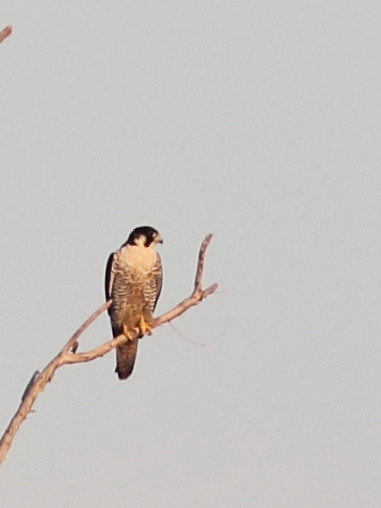
An immature Black Skimmer flew in on September 15, the first ever reported in our birding patch:
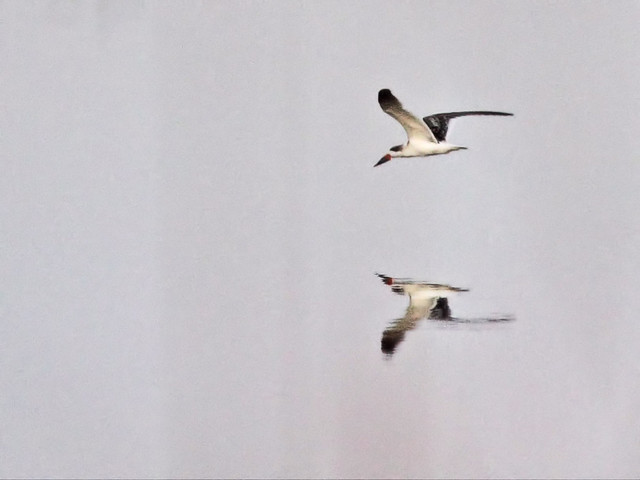
Mockingbirds alerted me to the presence of an immature Baltimore Oriole by chasing it out into the open on September 16:
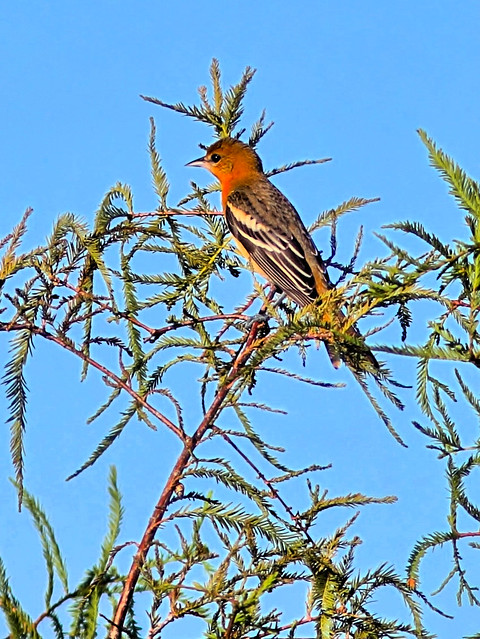
A European Starling had a vociferous confrontation with an exotic bird that probably "migrated" from its cage (September 3):
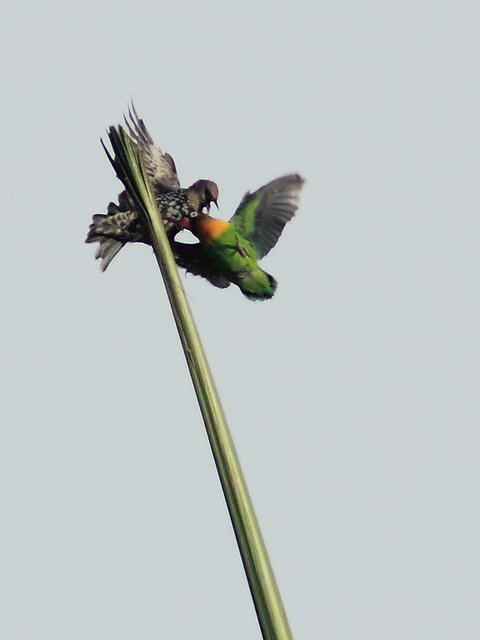
It was a Yellow-collared Lovebird, native of east Africa (also known by a variety of other names in the pet trade):
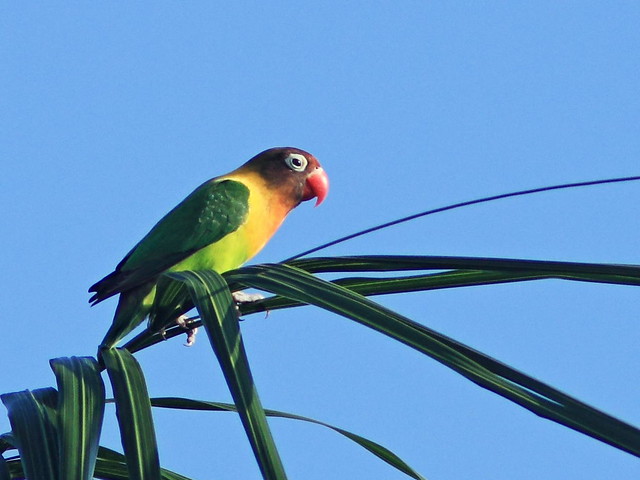
Not to be overlooked, Monarch butterflies are passing through on their multi-generational pilgrimage to Mexico. This one poses on a Duck Potato flower (September 17):
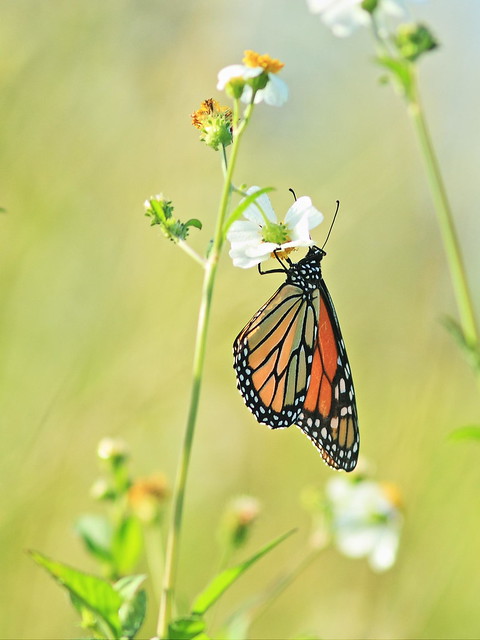
Here is an earlier photo of a Monarch, accompanied by a honeybee, on Ixora blossoms (January, 2015):
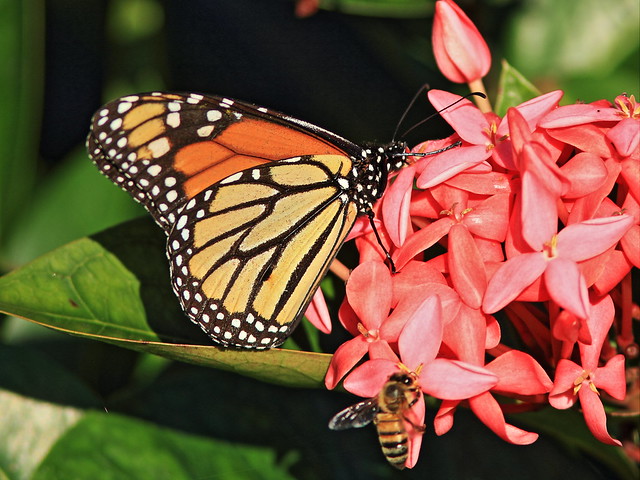
= = = = = = = = = = = = = = =
Linking to Misty's CAMERA CRITTERS,
Linking to Eileen's SATURDAY'S CRITTERS,
Linking to GOOD FENCES by Tex (Theresa).
Linking to WEEKEND REFLECTIONS by James
Linking to BirdD'Pot by Anni
Linking to Wild Bird Wednesday by Stewart
Linking to Today's Flowers Friday by Denise
Linking to Wordless Wednesday (on Tuesday) by NC Sue
________________________________________________
Please visit the links to all these memes to see some excellent photos on display
________________________________________________
Ken, Thanks for posting such an informative birding lesson. It requires such an enormous knowledge to spot and identify so many smaller birds, notwithstanding the skill to photograph them.
ReplyDeleteOne of these days I will venture west to your birding site and hope to encounter just a few of those posted.
Again, thanks for posting.
i'm going to have to try to view this again another time. once again, i saw about 2 of the photos. my connection won't load the others. *sigh*
ReplyDeleteHello, gorgeous sky shots. I love all the Sandpipers and the lovebird. Great post and photos. Enjoy your day and the week ahead!
ReplyDeleteOf course loved all the critters...but that first shot is awesome!!
ReplyDeleteAbsolutely glorious series, Kenneth! Gorgeous colours, details and reflections in your photos!
ReplyDeleteThank you. You have made me so glad with all your beautiful photos.
ReplyDeleteDo you have a special camera to capture the birds so close?
ReplyDeletegot it to load this afternoon! love the sun and reflections and bird shots.
ReplyDeleteBeautiful birds -- You are so lucky to witness this migration -- and we are lucky that you share your wonderful photos. Thank you.
ReplyDeleteBeautiful sunlight in your gate/fence shot.
ReplyDeleteSo many wonderful birds to look at today. I felt bad for the Lovebird but at least it's free now. Always a pleasure to view your wonderful photos.
Beautiful skies and stunning bird shots, as always....
ReplyDeleteAbsolutely stunning shots! Wonderful birds.
ReplyDeleteWhat a slew of great shots, KCS!
ReplyDeleteSandpipers are very cute birds.
~
Fascinating moon and sun observations!
ReplyDeleteGreat shots of our flying mates!
super photos as usual! Great reflections of the sandpipers.....I still haven't figured out how to tell the difference among all the sandpipers!!
ReplyDeleteYour photos are beautiful - birds and flowers.
ReplyDeleteSo many pretty bird captures! Yes, here the migratory birds have appeared too circling above our roof, not not a good lens to capture them! Also love the sunset, with the moon reflected -beautiful shot!
ReplyDeleteSo many beautiful pictures and phantastic reflections!
ReplyDeleteThat moon reflection is so cool!! Another great post. Enjoy your weekend.
ReplyDeleteSome wonderful photos. I especially like the Spotted Sandpiper.
ReplyDeleteGreat photos today. I always enjoy seeing your posts. Hope you can help me in identifying a bird on my blog today.
ReplyDeleteHello ken, wonderful collection of birds and photos. I love all the warblers and the pretty sandpipers. Thank you for linking up and sharing your critters. Happy Saturday, enjoy your weekend!
ReplyDeleteBy the way, I saw one of those Monarchs in Ashburn, Va. yesterday.
ReplyDelete~
We have been seeing some unusual birds this week. You see a lot we've never seen...like that Lovebird! And now I'm wondering if my mystery bird this week is a falcon. I hope you get a chance to look at it and tell me what you think. Enjoy your weekend! And thanks for sharing your amazing photos!
ReplyDeleteExtremely awesome today!!
ReplyDeleteSo much to view...such beauty. I liked the moonset on the lake, and I really REALLY appreciated the photo of the Greater and Lesser Yellowlegs side/side.
As always, I'm here not only to view your wonderful post, but also to send along my thanks for sharing with us birders at I'd Rather B Birdin' this weekend!
A beautiful series of photos!
ReplyDeleteHope you are having a great week-end!
Just an outstanding post Ken. Such beautiful shots of such an array of birds and the monarch. Always educational, too, especially for me. Thanks for sharing your knowledge and talents.
ReplyDeleteHello Ken!:) Setting out early morning does have it's advantages, and I just love your beautiful first shot of the moon reflected in the still water. As always, I enjoyed seeing all the different species of birds, all so beautiful in their own way,.. even the less colourful ones are so pretty. The Alder Flycatcher is a lovely little bird. Thank you for sharing your photos and knowledge.:)
ReplyDeleteAlways a pleasure to come and see the birds you have to share, and those pretty butterflies and flowers. Thanks for linking to Today's Flowers again, always very much appreciated.
ReplyDeleteThe colour and variety of your birds is such a delight to see. Really lovely pictures, especially the waders.
ReplyDeleteSuch stunning images of so many beautiful birds. Loving the Sandpiper reflections and the little blue-gray Gnatcatcher is particularly cute.
ReplyDeleteThe butterfly is beautiful.
Gorgeous colours in all of your images and you have very long legs!
Have a great week :)
Beautiful photos - as always!!!
ReplyDeleteThanks for linking up at http://image-in-ing.blogspot.com/2016/09/up-up-away.html
This is so awesome! I have wanted to go to Mexico and see the winter home of the Monarch Butterflies. I was able to go to Baja California last year and watch the birthing grounds of the gray whale. Lets see if I can see the butterflies one day.
ReplyDeleteA wonderful collection of some very pretty birds. The Falcon is a great shot
ReplyDeleteBeautiful shots of the place. Very cute birds.
ReplyDeleteIn response to Ruth's question, I use a Canon DSLR EOS 60D with a 420 mm telephoto lens system (fixed 300 mm L/4 + 1.4x extender) which produces an aperture of f/5.6.
ReplyDeleteA lovely view of the lake. The falcons are handsome birds.
ReplyDelete